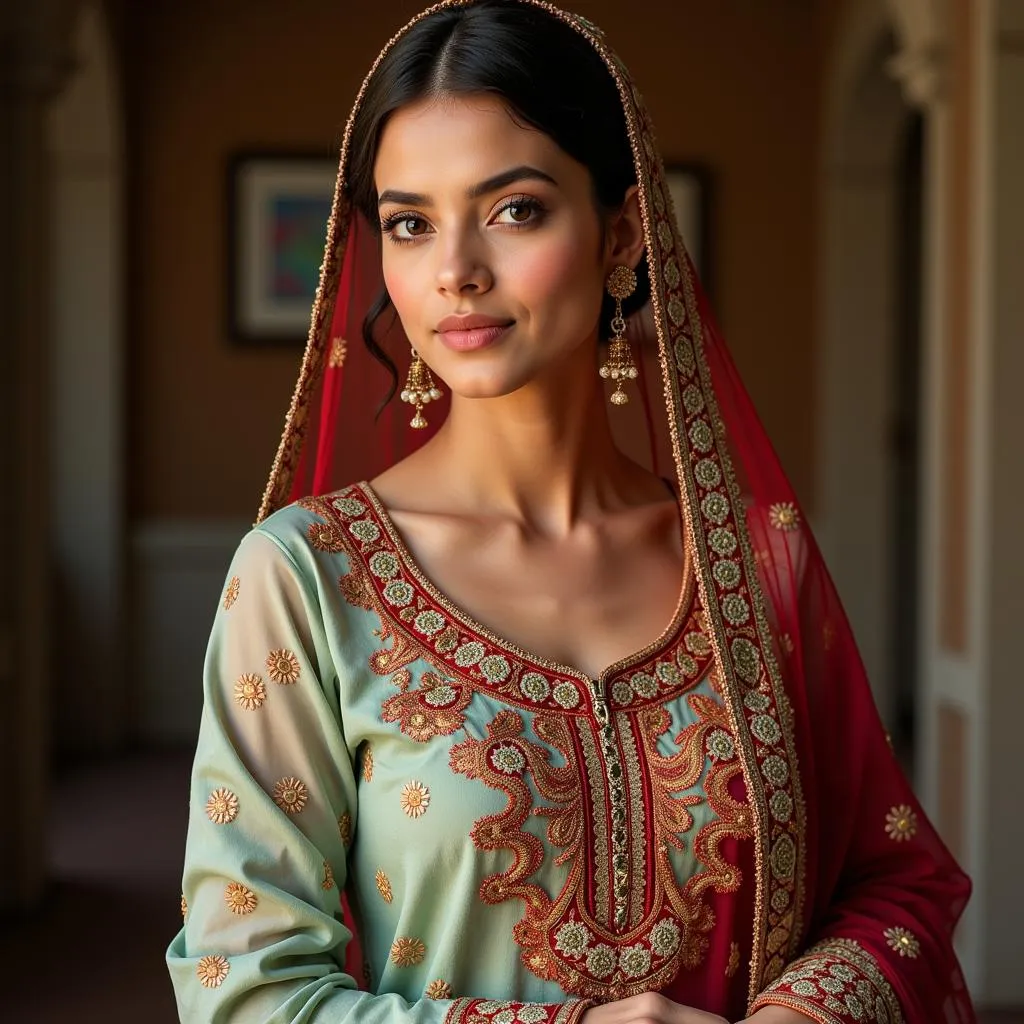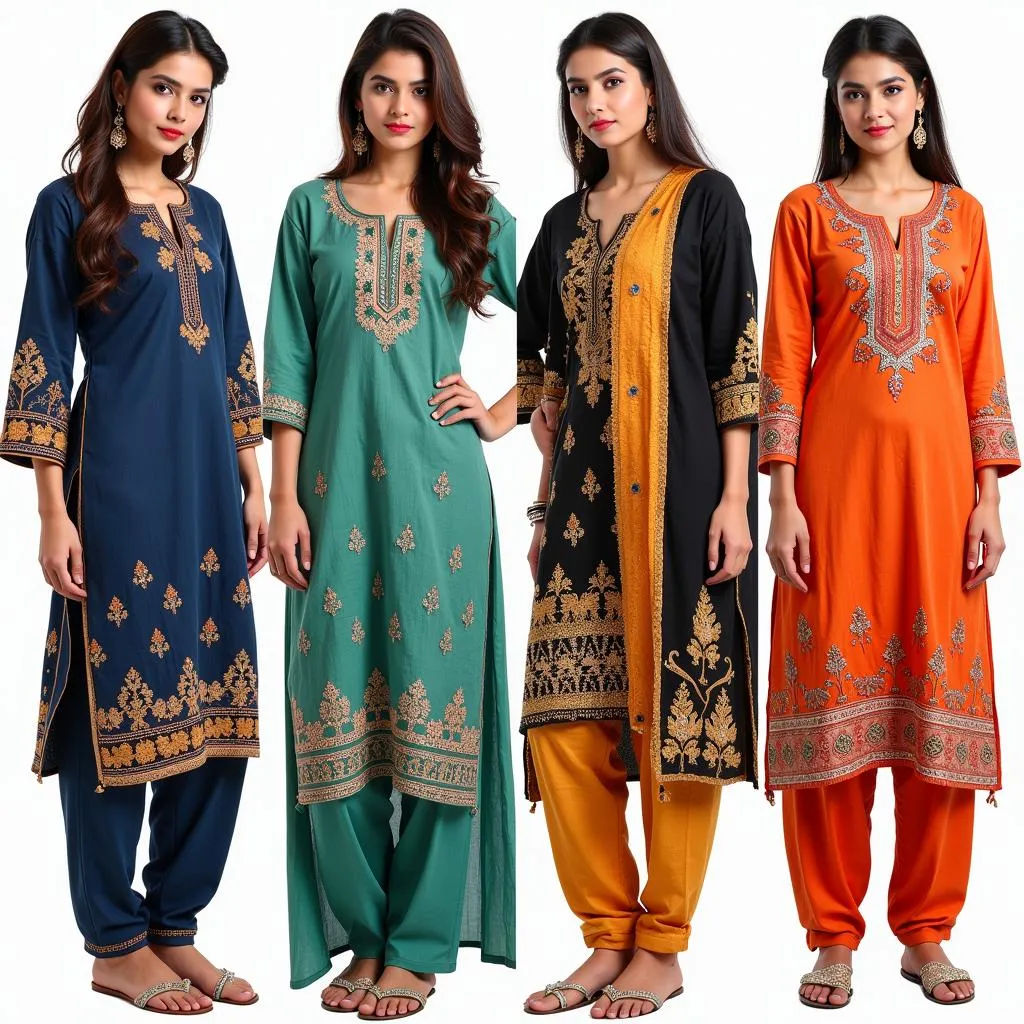Pakistan, a land brimming with vibrant culture and heritage, boasts a diverse array of traditional dresses that reflect its fascinating history and regional influences. These garments, woven with intricate artistry and steeped in symbolism, are a testament to the country’s rich textile traditions and the aesthetic sensibilities of its people. From the flowing shalwar kameez to the majestic sherwani, Pakistan Traditional Dress offers a glimpse into the country’s soul.
 A woman gracefully adorned in a vibrant shalwar kameez, showcasing the intricate embroidery and flowing silhouette.
A woman gracefully adorned in a vibrant shalwar kameez, showcasing the intricate embroidery and flowing silhouette.
The Ubiquitous Shalwar Kameez: A Symbol of Elegance
The shalwar kameez, undoubtedly the most recognizable Pakistan traditional dress, is a testament to its versatility and timeless appeal. This ensemble, worn by both men and women across the country, comprises a loose-fitting, pajama-like trouser (shalwar) paired with a long tunic (kameez). The kameez can vary in length, cut, and embellishments, allowing for a wide range of styles suitable for various occasions.
For women, the shalwar kameez is often complemented by a dupatta, a long scarf draped over the head or shoulders. The dupatta adds an element of grace and modesty to the attire and can be crafted from a variety of fabrics, ranging from delicate silk to richly embroidered cotton.
A Kaleidoscope of Regional Variations
While the shalwar kameez serves as a unifying garment, each region of Pakistan has its unique interpretation of this traditional dress. In Punjab, for instance, women often favor brightly colored shalwar kameez with intricate phulkari embroidery, while in Sindh, the preference leans towards lighter fabrics and delicate mirror work. The Balochistan region is known for its bold and vibrant embroidery, while Khyber Pakhtunkhwa showcases a more austere style, often featuring intricate beadwork.
 A collage featuring different regional variations of shalwar kameez, showcasing the diversity in colors, fabrics, and embroidery styles.
A collage featuring different regional variations of shalwar kameez, showcasing the diversity in colors, fabrics, and embroidery styles.
Men’s Traditional Attire: A Blend of Majesty and Sophistication
For men, the sherwani stands as a symbol of elegance and grandeur. This long, coat-like garment, often made from rich fabrics like silk or velvet, is typically worn over a shalwar kameez. The sherwani is often heavily embellished with embroidery, particularly around the collar, cuffs, and placket. It is typically reserved for special occasions such as weddings and religious festivals.
Another popular choice for men is the kurta pajama, a more casual yet stylish option. The kurta, a long, loose-fitting shirt, is paired with loose-fitting pajamas. While the kurta pajama can be made from a variety of fabrics, cotton is a popular choice for its comfort and breathability.
“The sherwani is a timeless piece of clothing that exudes both regality and sophistication,” says fashion designer Asim Jofa. “Its intricate embroidery and tailored silhouette make it a perfect choice for men who want to make a statement.”
The Significance of Colors and Embellishments
Colors and embellishments play a vital role in Pakistan traditional dress, adding layers of meaning and symbolism to the garments. For instance, red is often associated with joy and celebration, while green symbolizes prosperity and good fortune. White is a symbol of purity, while black is reserved for mourning.
Embroidery techniques, too, vary widely across the country. Phulkari, originating from Punjab, is a vibrant embroidery style that uses geometric patterns and bright colors. Mirror work, popular in Sindh, involves stitching small mirrors onto the fabric to create shimmering patterns. Balochi embroidery is known for its bold and colorful designs, often featuring motifs inspired by nature.
Pakistan Traditional Dress: A Timeless Legacy
Pakistan traditional dress is more than just clothing; it is a reflection of the country’s rich cultural heritage and artistic traditions. These garments, passed down through generations, carry with them stories of history, craftsmanship, and cultural identity. In a world of fast fashion, Pakistan traditional dress remains a timeless classic, celebrated for its elegance, beauty, and enduring appeal.
Frequently Asked Questions about Pakistan Traditional Dress
1. What is the most common Pakistan traditional dress?
The shalwar kameez is the most common Pakistan traditional dress, worn by both men and women across the country.
2. What is a sherwani?
A sherwani is a long, coat-like garment worn by men over a shalwar kameez. It is often made from rich fabrics like silk or velvet and is heavily embellished with embroidery.
3. What is the significance of colors in Pakistan traditional dress?
Colors play a vital role in Pakistan traditional dress, adding layers of meaning and symbolism. Red is often associated with joy and celebration, while green symbolizes prosperity and good fortune.
4. Where can I buy Pakistan traditional dress?
Pakistan traditional dress can be found in various markets and boutiques throughout Pakistan. Many online retailers also specialize in selling Pakistan traditional dress.
5. What is the best way to care for Pakistan traditional dress?
Most Pakistan traditional dress garments are made from delicate fabrics and require careful handling. It is best to hand wash or dry clean these garments to preserve their beauty.
You Might Also Be Interested In
Need Help?
For assistance with any questions or to learn more about Pakistan traditional dress, please contact us:
- Phone: +923337849799
- Email: [email protected]
- Address: Dera Ghazi Khan Rd, Rakhni, Barkhan, Balochistan, Pakistan
Our customer care team is available 24/7 to assist you.